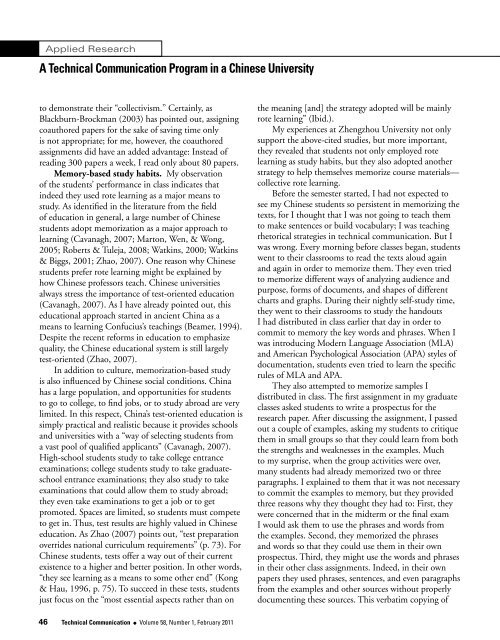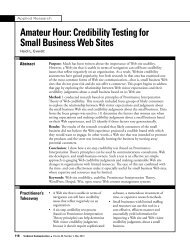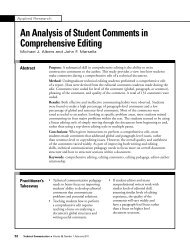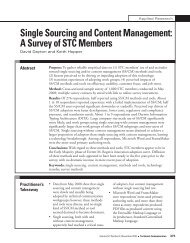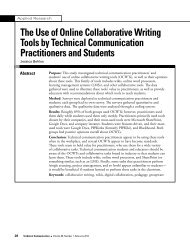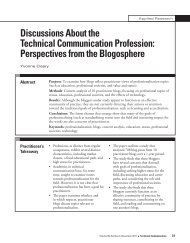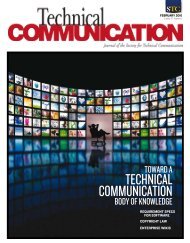When Traditional Chinese Culture Meets a Technical ...
When Traditional Chinese Culture Meets a Technical ...
When Traditional Chinese Culture Meets a Technical ...
Create successful ePaper yourself
Turn your PDF publications into a flip-book with our unique Google optimized e-Paper software.
Applied ResearchA <strong>Technical</strong> Communication Program in a <strong>Chinese</strong> Universityto demonstrate their “collectivism.” Certainly, asBlackburn-Brockman (2003) has pointed out, assigningcoauthored papers for the sake of saving time onlyis not appropriate; for me, however, the coauthoredassignments did have an added advantage: Instead ofreading 300 papers a week, I read only about 80 papers.Memory-based study habits. My observationof the students’ performance in class indicates thatindeed they used rote learning as a major means tostudy. As identified in the literature from the fieldof education in general, a large number of <strong>Chinese</strong>students adopt memorization as a major approach tolearning (Cavanagh, 2007; Marton, Wen, & Wong,2005; Roberts & Tuleja, 2008; Watkins, 2000; Watkins& Biggs, 2001; Zhao, 2007). One reason why <strong>Chinese</strong>students prefer rote learning might be explained byhow <strong>Chinese</strong> professors teach. <strong>Chinese</strong> universitiesalways stress the importance of test-oriented education(Cavanagh, 2007). As I have already pointed out, thiseducational approach started in ancient China as ameans to learning Confucius’s teachings (Beamer, 1994).Despite the recent reforms in education to emphasizequality, the <strong>Chinese</strong> educational system is still largelytest-oriented (Zhao, 2007).In addition to culture, memorization-based studyis also influenced by <strong>Chinese</strong> social conditions. Chinahas a large population, and opportunities for studentsto go to college, to find jobs, or to study abroad are verylimited. In this respect, China’s test-oriented education issimply practical and realistic because it provides schoolsand universities with a “way of selecting students froma vast pool of qualified applicants” (Cavanagh, 2007).High-school students study to take college entranceexaminations; college students study to take graduateschoolentrance examinations; they also study to takeexaminations that could allow them to study abroad;they even take examinations to get a job or to getpromoted. Spaces are limited, so students must competeto get in. Thus, test results are highly valued in <strong>Chinese</strong>education. As Zhao (2007) points out, “test preparationoverrides national curriculum requirements” (p. 73). For<strong>Chinese</strong> students, tests offer a way out of their currentexistence to a higher and better position. In other words,“they see learning as a means to some other end” (Kong& Hau, 1996, p. 75). To succeed in these tests, studentsjust focus on the “most essential aspects rather than onthe meaning [and] the strategy adopted will be mainlyrote learning” (Ibid.).My experiences at Zhengzhou University not onlysupport the above-cited studies, but more important,they revealed that students not only employed rotelearning as study habits, but they also adopted anotherstrategy to help themselves memorize course materials—collective rote learning.Before the semester started, I had not expected tosee my <strong>Chinese</strong> students so persistent in memorizing thetexts, for I thought that I was not going to teach themto make sentences or build vocabulary; I was teachingrhetorical strategies in technical communication. But Iwas wrong. Every morning before classes began, studentswent to their classrooms to read the texts aloud againand again in order to memorize them. They even triedto memorize different ways of analyzing audience andpurpose, forms of documents, and shapes of differentcharts and graphs. During their nightly self-study time,they went to their classrooms to study the handoutsI had distributed in class earlier that day in order tocommit to memory the key words and phrases. <strong>When</strong> Iwas introducing Modern Language Association (MLA)and American Psychological Association (APA) styles ofdocumentation, students even tried to learn the specificrules of MLA and APA.They also attempted to memorize samples Idistributed in class. The first assignment in my graduateclasses asked students to write a prospectus for theresearch paper. After discussing the assignment, I passedout a couple of examples, asking my students to critiquethem in small groups so that they could learn from boththe strengths and weaknesses in the examples. Muchto my surprise, when the group activities were over,many students had already memorized two or threeparagraphs. I explained to them that it was not necessaryto commit the examples to memory, but they providedthree reasons why they thought they had to: First, theywere concerned that in the midterm or the final examI would ask them to use the phrases and words fromthe examples. Second, they memorized the phrasesand words so that they could use them in their ownprospectus. Third, they might use the words and phrasesin their other class assignments. Indeed, in their ownpapers they used phrases, sentences, and even paragraphsfrom the examples and other sources without properlydocumenting these sources. This verbatim copying of46 <strong>Technical</strong> Communication l Volume 58, Number 1, February 2011


